- What Exactly IS Positive Reinforcement? (Spoiler: It's More Than Just Treats!)
- The Golden Rules: Core Principles of Positive Reinforcement Training
- Gearing Up for Success: Your Positive Reinforcement Toolkit
- Putting it into Practice: Teaching Basic Commands the Positive Way
- Tackling Common Bully Challenges with Positive Solutions
- Why Your American Bully (and You!) Will Thrive with Positive Reinforcement
- Clearing the Air: Common Questions & Myths about Positive Bully Training
- Level Up Your Training: Resources and Next Steps
- Conclusion: A Partnership Built on Positivity
Welcome, fellow American Bully lovers! If you share your life with one of these incredible dogs, you already know about their immense capacity for love, loyalty, and intelligence. Beneath that muscular exterior beats the heart of a sensitive companion eager to please their favourite humans. But when it comes to training, myths and misconceptions often cloud the picture, suggesting these powerful dogs need a “firm” or even harsh hand. We’re here to tell you there’s a better, more effective, and infinitely more rewarding way: positive reinforcement American Bully training.
Forget outdated ideas about dominance and correction. Positive reinforcement isn’t just a training technique; it’s a philosophy built on understanding, communication, and mutual respect. It harnesses your Bully’s natural desire to learn and work with you, strengthening your bond every step of the way. This article will be your comprehensive guide to understanding why positive dog training is particularly perfect for your American Bully dog breed, how its core principles work, and how you can apply these effective American Bully training techniques to teach basic commands, address common challenges, and build an unbreakable partnership with your beloved companion. Get ready to unlock your Bully’s full potential through the power of positivity!
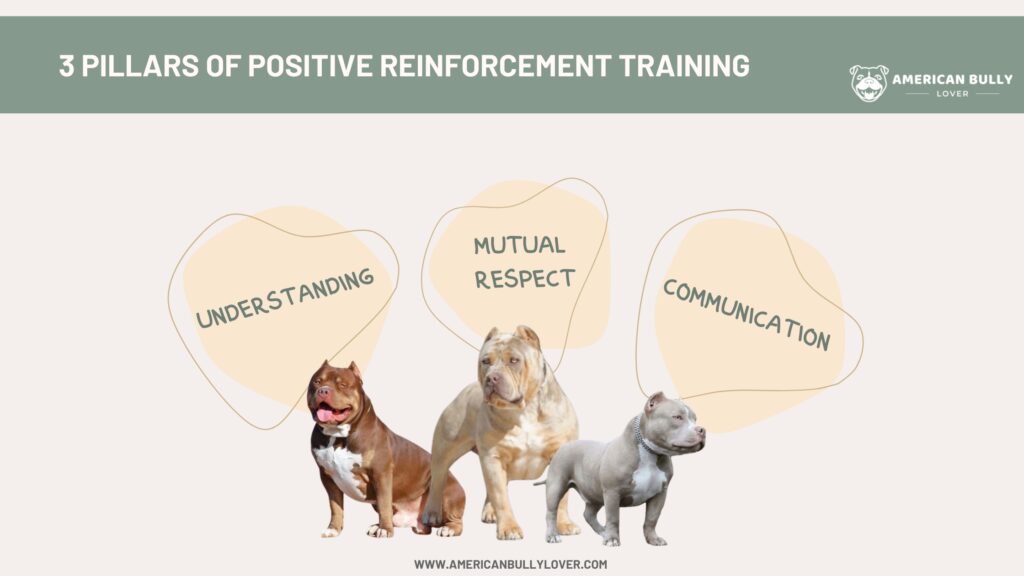
What Exactly IS Positive Reinforcement? (Spoiler: It’s More Than Just Treats!)
So, what do we mean by “positive reinforcement”? At its heart, it’s incredibly simple:
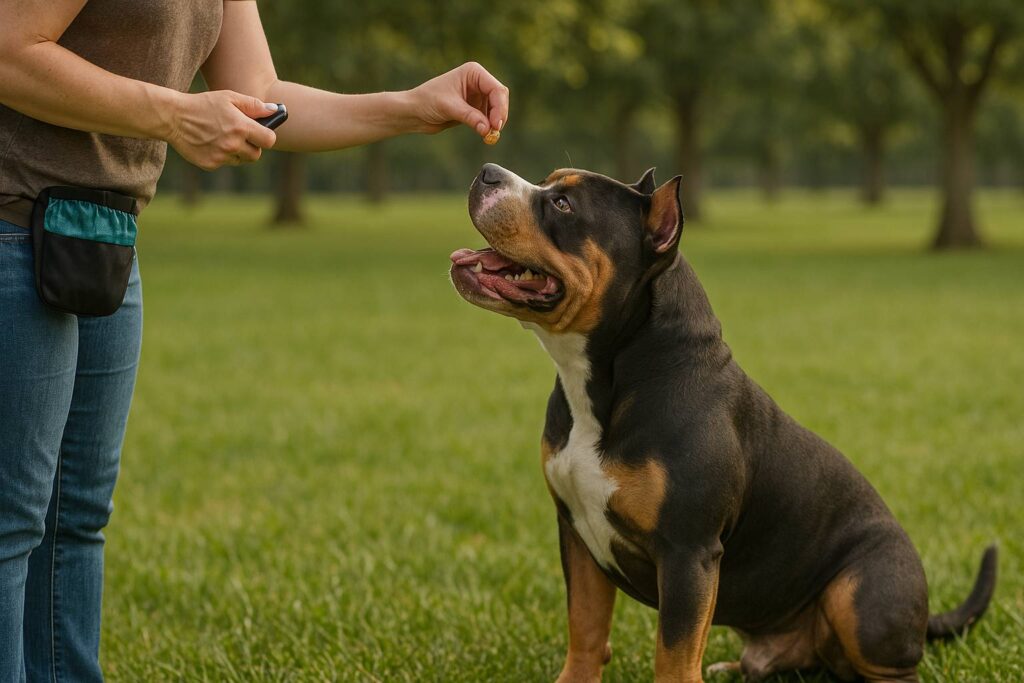
You add something your dog finds desirable (a tasty treat, enthusiastic praise, a fun toy, a good ear scratch) immediately after they perform a behavior you like. This makes them more likely to repeat that behavior in the future.
Think of it like this: Behavior + Pleasant Consequence = Behavior Happens More Often.
The science behind it, rooted in operant conditioning, shows that animals (and people!) learn effectively when their actions lead to positive outcomes. Instead of focusing on stopping “bad” behavior through punishment (which can create fear, anxiety, and even aggression), reward-based training for American Bullies focuses on teaching and rewarding the “good” behavior you want to see.
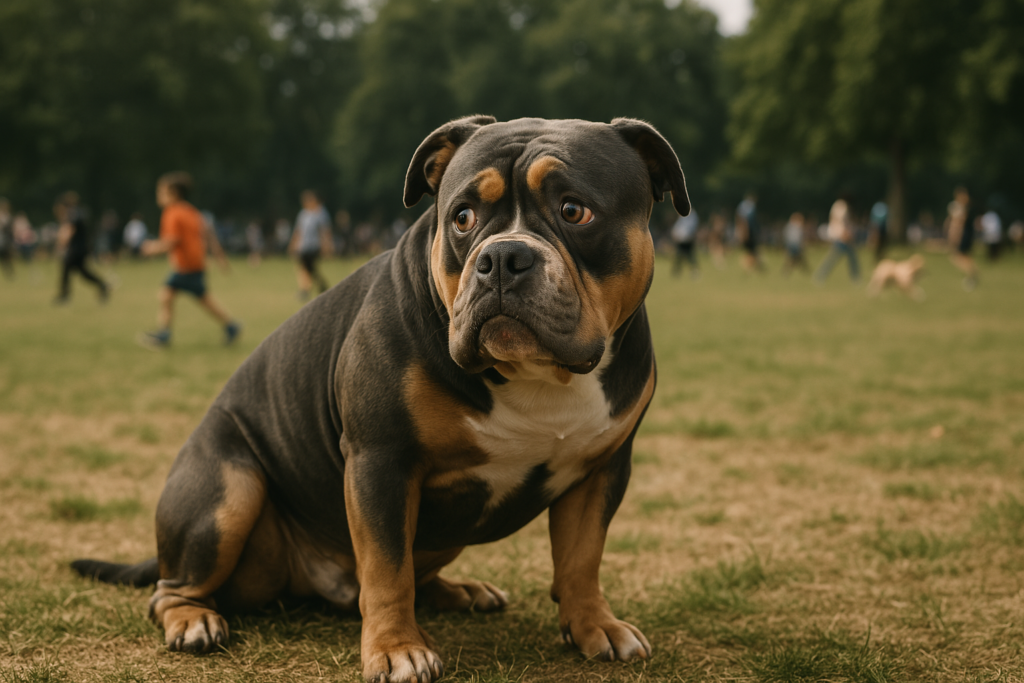
Why it Works Wonders for Bullies:
American Bullies, despite their tough looks, are often surprisingly sensitive souls. They form deep bonds with their families and genuinely want to please. Positive reinforcement taps directly into this:
- Builds Confidence: Rewarding success helps your Bully feel secure and confident in learning new things, combating any unfair stereotypes.
- Fosters Partnership: Training becomes a fun game you play together, not a battle of wills. Your Bully learns to eagerly offer behaviors, hoping for a reward.
- Avoids Negative Fallout: Harsh methods can create anxiety, fear, or reactivity. Positive reinforcement avoids this, nurturing a stable and happy temperament.
- Leverages Intelligence: Bullies are smart! Positive training engages their minds and channels their problem-solving skills constructively. Using positive reinforcement American Bully training methods respects their intelligence and sensitivity.
Many wonder why this is better than correction-based methods. The answer lies in motivation and relationship. Positive reinforcement builds enthusiastic cooperation based on trust, while punishment often leads to compliance based on fear or avoidance, which can damage the bond and create other behavioral issues.
The Golden Rules: Core Principles of Positive Reinforcement Training
To make positive reinforcement truly effective, especially when considering American Bully training methods, follow these golden rules:
- Rule 1: Impeccable Timing: This is crucial! The reward must happen within 1-2 seconds of the desired behavior. Any later, and your Bully might think they’re being rewarded for something else entirely. This is where a “marker signal” comes in handy – a short, unique sound (like the click of a clicker or a verbal cue like “Yes!”) that tells your dog exactly when they did the right thing. The marker pinpoints the moment, and the reward follows immediately after.
- Rule 2: Consistency is Crucial: Everyone in the household needs to use the same cues, rules, and rewards. If “Sit” means sit, it needs to mean sit whether Mom, Dad, or the kids ask. Inconsistency confuses your dog and slows down learning. Consistency is key for clear communication.
- Rule 3: Know Your Dog’s Currency (High-Value Rewards): What does your Bully really love? Not all rewards are created equal! Discover what truly motivates your individual dog. This might involve experimenting:
- Treat Hierarchy: Some treats are okay (kibble), some are good (store-bought training treats), and some are AMAZING (tiny pieces of cooked chicken, cheese, hot dogs). Use the highest value treats for learning new or difficult things. Treat training your American Bully effectively means finding what they adore.
- Toys: Does your Bully love tug-of-war or fetch? A quick game can be a powerful reward.
- Praise & Affection: Enthusiastic verbal praise (“Good boy/girl!”), petting, or ear scratches can be very rewarding, especially once a behavior is known.
- Life Rewards: Getting to go outside, sniffing a favourite spot, greeting a person – these can also be used as rewards for calm behaviour.
- Rule 4: Keep it Short, Sweet, and Successful: Aim for short, frequent training sessions (5-10 minutes) rather than long, potentially frustrating ones. Keep the energy upbeat and fun! Always try to end the session on a high note, with a successful repetition of a behavior your dog knows well. This leaves them eager for the next session.
- Rule 5: Clear Communication: Use clear, simple verbal cues (one word is usually best, like “Sit,” “Stay,” “Come”). Pair the cue with the action as your dog is doing it initially, then start saying it just before. Use consistent hand signals if you like. Your positive attitude and clear body language are also part of the communication!
Gearing Up for Success: Your Positive Reinforcement Toolkit
You don’t need a lot of fancy equipment, but a few key items make positive reinforcement training much smoother:
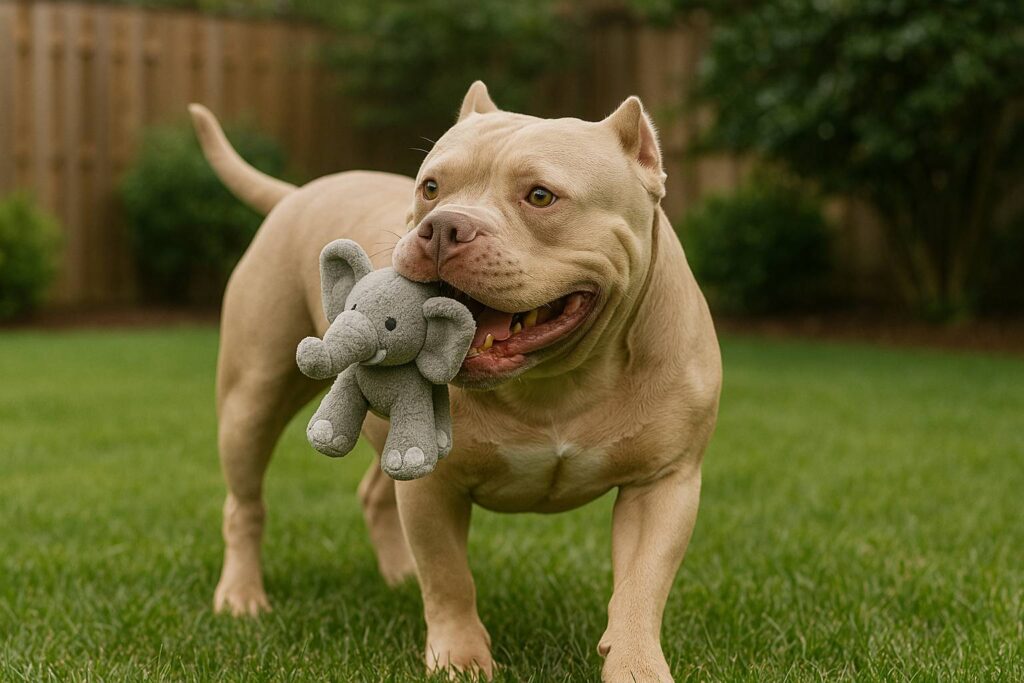
- Essential #1: High-Value Treats: Prepare tiny, pea-sized, soft, and preferably smelly treats that your Bully goes crazy for. Soft treats are quick to eat, keeping the training pace up. Remember tiny portions – you’ll be using quite a few!
- Essential #2: Treat Pouch: A simple pouch that clips onto your belt or pocket keeps your hands free and allows for lightning-fast reward delivery. This is crucial for good timing!
- Optional but Recommended: Clicker: A small plastic device that makes a distinct “click” sound. As mentioned, it’s excellent for precisely marking the exact moment your dog performs the desired behavior. If you choose not to use a clicker, pick a consistent verbal marker like “Yes!” or “Good!” said in a bright, happy tone. Clicker training your American Bully can significantly speed up learning for many dogs.
- Optional: Favorite Toys: Keep a special tug toy or ball handy if your Bully is highly motivated by play. A quick game can be a fantastic reward, especially for high-energy moments.
- The Most Important Tool: Patience and a Positive Attitude! Your enthusiasm, patience, and belief in your dog are the secret ingredients. Training is a journey, celebrate the small successes!
Putting it into Practice: Teaching Basic Commands the Positive Way
Ready to see positive reinforcement American Bully training in action? Let’s break down how to teach some essential commands:
Mastering the “Sit”
- Luring: Hold a high-value treat near your Bully’s nose. Slowly move it upwards and slightly back over their head. As their nose follows the treat up, their rear end will naturally lower. The instant their bottom touches the floor, Mark (Click or “Yes!”) and give the treat. Repeat several times.
- Capturing: Keep treats handy. When you see your Bully sit on their own, Mark and reward! This teaches them that sitting is a profitable activity.
- Adding the Cue: Once your Bully is reliably sitting using the lure, start saying the word “Sit” just as their rear is heading down. Soon, they’ll associate the word with the action.
- Fading the Lure: Gradually make the hand motion smaller, without a treat actually in it (but still reward from your other hand/pouch). Eventually, you should just need the verbal cue or a subtle hand signal.
Achieving a Reliable “Stay”
- Start Simple: Ask your Bully for a “Sit” (or “Down”). Mark and reward. Then, say “Stay” with a clear hand signal (like a flat palm facing them). Wait only one second, Mark and reward if they stayed.
- Build Duration: Gradually increase the time you wait before marking and rewarding – go from 1 second to 2, then 3, then 5, etc. If they break the stay, calmly reset them and ask for a shorter duration next time. Reward frequently for success!
- Add Distance & Distractions (The 3 D’s): Once they understand duration, add distance (take one step back, return, Mark & reward). Then slowly add distractions (another person walking by, a toy squeaking softly). Go slow and set your dog up for success.
- Release Cue: Always use a release word (“Okay!” “Free!”) to tell them the stay is over. Don’t let them just decide to get up.
The Joyful “Come” (Recall)
- Make it a Party! Recall should be the best thing ever. Use an upbeat, happy tone (“Fido, Come!”). When they start moving towards you, praise enthusiastically. When they reach you, Mark and reward generously with high-value treats, toys, and affection.
- Never Punish: Never ever scold your Bully for coming, even if they took ages or were doing something naughty before you called. You want them to always think coming to you is wonderful and safe.
- Practice Safely: Start in a quiet area with no distractions. Use a long line (15-30 feet) attached to a harness (not collar) in unfenced areas for safety, so they can’t ignore you and run off. Reel them in gently if needed, rewarding when they get to you.
- Keep it Fun: Play recall games! Hide and call them, have family members take turns calling them back and forth.
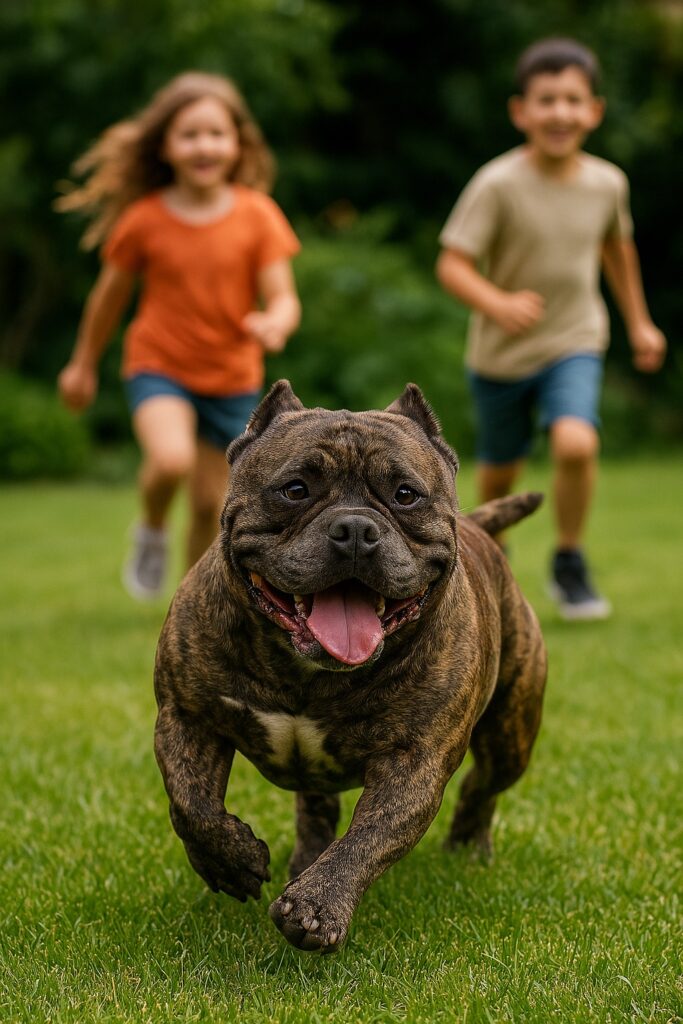
Loose-Leash Walking Bliss
- Reward the Good Stuff: Before the leash even tightens, Mark and reward your Bully for walking nicely beside you, looking at you, or having slack in the leash.
- Be a Tree: The moment the leash tightens, stop walking. Stand still and silent like a tree. Wait. When your Bully eventually slackens the leash (even slightly, perhaps by turning back towards you), immediately Mark and start walking again. They learn: Loose Leash = We Walk, Tight Leash = We Stop.
- Location, Location, Location: Start practicing in low-distraction areas. Gradually work up to busier environments as they improve.
- Equipment Matters: A front-clip harness can be helpful for heavy pullers, as it gently redirects them towards you when they pull, making it easier to reward the loose leash. Avoid choke chains, prong collars, or shock collars, which rely on pain/discomfort and go against positive reinforcement principles.
Yes, you absolutely can teach your strong American Bully to sit, stay, come, and walk nicely using only rewards! It requires patience and consistency, but the results are reliable behaviors performed willingly and happily.
Tackling Common Bully Challenges with Positive Solutions
Every dog owner faces challenges, and positive reinforcement offers effective, humane solutions for common Bully behaviors:
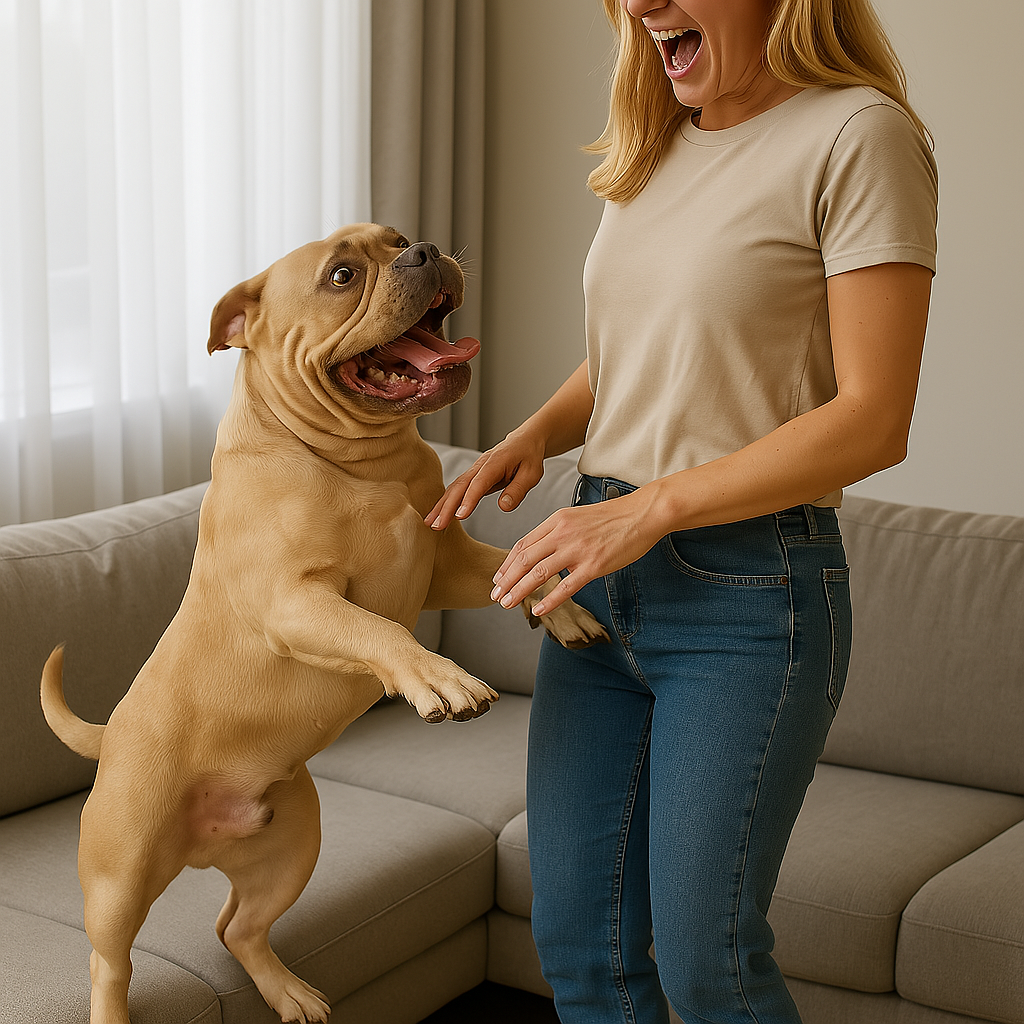
- Challenge 1: Over-Excitement (Jumping on Guests, Play Nipping):
- Solution: Don’t reward the jumping! Ask guests to turn away or ignore your Bully until all four paws are on the floor, then give calm attention. Better yet, teach an alternative behavior: train a rock-solid “Sit” or “Go to Mat” for greetings. Mark and reward heavily for keeping paws down. For play nipping, immediately redirect their mouth onto an appropriate chew toy. If nipping continues during play, calmly end the game for a minute (negative punishment – removing fun). Reward gentle play.
- Challenge 2: Building Confidence (Fear/Anxiety with Noises, Objects, Situations):
- Solution: Use counter-conditioning and desensitization (CC&DS). Pair the scary thing (at a distance where your dog notices but isn’t panicked) with fantastic treats. Scary noise far away? Treat! Person with a hat across the street? Treat! The goal is to change the association from scary to “predictor of yummy things.” Never force your Bully to confront their fears up close. Let them approach at their own pace, rewarding curiosity and bravery. Consider seeking help from a certified professional for significant fear issues.
- Challenge 3: Positive Socialization:
- Solution: Socialization isn’t just exposing your dog to things; it’s ensuring those exposures are positive. Introduce your Bully calmly to well-behaved, vaccinated adult dogs. Keep initial interactions short and sweet. Pair seeing other dogs (from a distance initially) with treats. Introduce new people, sights, and sounds gradually, always associating them with good things (treats, praise). Quality over quantity is key! Effective American Bully training techniques must include proper socialization.
- For a deep dive into this crucial topic, read our posts on How Friendly are American Bullies with Other Animals? and The Gentle Side: Understanding the American Bully Temperament.
- Challenge 4: The “Stubborn Streak” Myth:
- Solution: Dogs, including Bullies, aren’t typically stubborn out of spite. If your Bully isn’t responding, ask yourself:
- Are my instructions clear? Does my dog truly understand what I’m asking?
- Is the reward motivating enough? Maybe kibble isn’t cutting it for this difficult task. Try higher value treats!
- Is the task too hard right now? Break it down into smaller, easier steps.
- Is the environment too distracting? Practice in a quieter place first.
- Is my dog stressed, tired, or uncomfortable? Rule out physical issues or anxiety.
- Reframe “stubbornness” as a communication challenge. How to positively reinforce your American Bully effectively often means troubleshooting why they aren’t succeeding and adjusting your approach. This empathetic view is central to positive dog training for American Bullies, whether you have a Pocket American Bully or a large American Bully XL – understanding their individual needs is key. Managing the strength of an excited XL Bully, for instance, requires focusing heavily on rewarding calm behaviour before they get overly aroused.
- Solution: Dogs, including Bullies, aren’t typically stubborn out of spite. If your Bully isn’t responding, ask yourself:
Why Your American Bully (and You!) Will Thrive with Positive Reinforcement
Choosing reward-based training for American Bullies isn’t just about getting a well-behaved dog; it’s about transforming your relationship. The benefits are profound:
- Benefit 1: A Rock-Solid Bond: Training becomes a shared language built on trust and positive experiences. You become a team, strengthening your connection daily.
- Benefit 2: A Confident, Happy Dog: Success breeds confidence! Positive reinforcement helps your Bully feel secure, capable, and less anxious about the world. A happy dog is a joy to live with.
- Benefit 3: An Eager and Engaged Learner: Dogs trained positively often love training sessions! They eagerly participate, offer behaviours, and enjoy the mental stimulation.
- Benefit 4: Proactive Problem Prevention: By focusing on teaching and rewarding what you want your dog to do, you proactively reduce the chances of unwanted behaviors cropping up out of confusion or frustration.
- Benefit 5: Ethical, Humane, and Safe: This is perhaps the most crucial benefit. Positive reinforcement avoids the use of fear, pain, or intimidation, safeguarding your Bully’s physical and emotional well-being. It’s a training method you can feel good about.
Embracing these effective American Bully training techniques leads to a partnership built on joy and mutual understanding.
Clearing the Air: Common Questions & Myths about Positive Bully Training
It’s natural to have questions when exploring American Bully training methods. Let’s address some common ones:
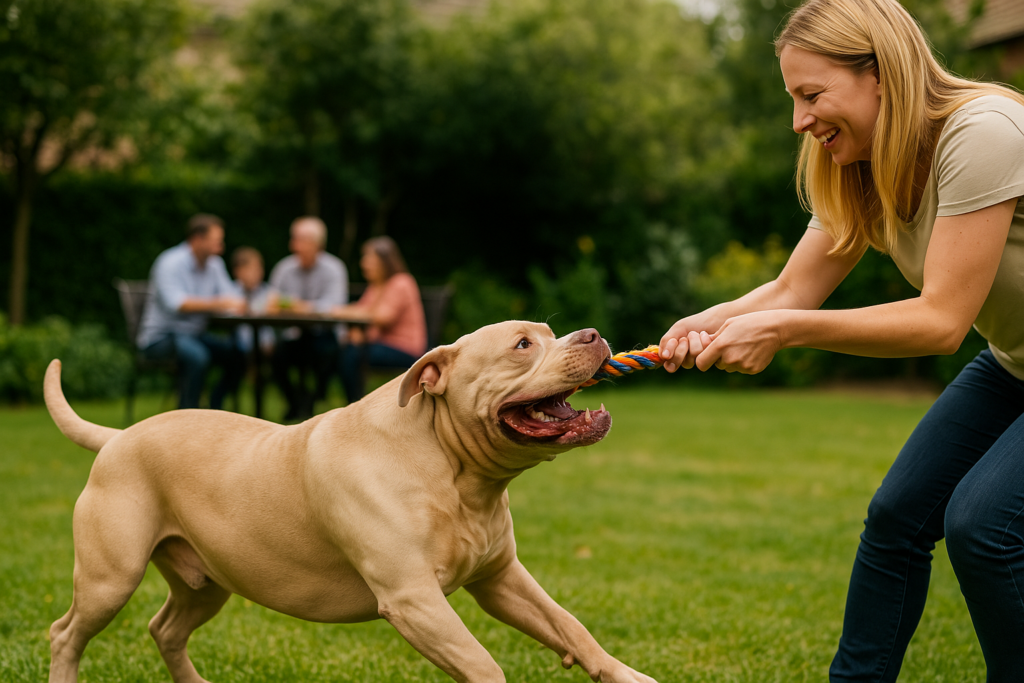
- Myth Busting #1: “Do positive methods work for strong/tough/dominant breeds like Bullies?”
- Answer: Absolutely, YES! Strength and determination are breed traits, but “dominance” as a driver for everyday dog behavior is an outdated and largely debunked theory. Positive reinforcement works for all breeds because it taps into the universal principles of learning and motivation. It’s about clear communication and rewarding cooperation, not physical overpowering. Gentle American Bully training is powerful!
- Myth Busting #2: “Will I have to carry treats forever?”
- Answer: No! Treats are crucial for teaching new behaviors and rewarding in highly distracting environments. Once a behavior is well-learned, you’ll fade the lure (the treat used to guide them), use treats more intermittently (not every single time), and start incorporating “real-life rewards” – praise, petting, toys, sniffing breaks, getting to go through a door, etc. The goal is a dog who responds reliably, not one who only works if they see food first. Treat training your American Bully is a starting point, not the endpoint.
- Myth Busting #3: “Isn’t it just bribery?”
- Answer: Think of it as payment for a job well done, not bribery. Bribery is showing the reward upfront to entice action; positive reinforcement marks and rewards the action after it happens. It builds a positive association with the behavior and a strong work ethic based on understanding and positive consequences.
- Myth Busting #4: “What if my Bully isn’t food-motivated?”
- Answer: While most dogs can be motivated by the right food if it’s high-value enough, some dogs truly prefer other rewards. Experiment! Find out what makes your Bully’s eyes light up. Is it a specific squeaky toy? A vigorous game of tug? Enthusiastic praise? A good butt scratch? The principles of positive reinforcement remain the same – use whatever your dog finds genuinely rewarding!
- Myth Busting #5: “Is positive reinforcement too slow or not firm enough?”
- Answer: Positive reinforcement builds understanding and enthusiasm, leading to more reliable, long-lasting behaviors than methods based on fear or avoidance. While teaching a new behavior might take thoughtful steps, the results are robust. “Firmness” in training comes from clear communication, consistent boundaries, and following through, not from physical force or intimidation. Force-free American Bully training is both kind and effective.
Level Up Your Training: Resources and Next Steps
Ready to dive deeper into the world of positive reinforcement American Bully training? Here are some resources:
- Finding Professional Help: Sometimes, expert guidance makes all the difference. Look for certified positive reinforcement trainers in your area. Key certifications include CPDT-KA or CPDT-KSA (Certification Council for Professional Dog Trainers), KPA CTP (Karen Pryor Academy Certified Training Partner), or others focusing on science-based, humane methods. Avoid trainers who talk about being “alpha,” use choke chains, prong collars, or shock collars.
- (External Link Placeholder): Find a Certified Trainer Directory (e.g., [External Link: https://www.ccpdt.org/dog-owners/certified-dog-trainer-directory/] or [External Link: https://karenpryoracademy.com/find-a-trainer/] )
- Recommended Reading/Viewing: Immerse yourself in positive training philosophy.
- (External Link Placeholder): Explore resources like Karen Pryor Clicker Training ([External Link: https://www.clickertraining.com]) or watch Kikopup’s excellent training videos on YouTube ([External Link: https://www.youtube.com/user/kikopup]). Consider books like “The Power of Positive Dog Training” by Pat Miller.
- Local Positive Training Classes: Group classes offer socialization opportunities (for dogs and owners!), practice around distractions, and guidance from a qualified instructor. Ensure the facility explicitly uses positive reinforcement methods.
- Connect with the Community: Look for online groups or forums dedicated to American Bullies and positive reinforcement training. Share experiences and learn from others (always verify advice aligns with positive principles).
Conclusion: A Partnership Built on Positivity
Training your American Bully doesn’t have to be a struggle. By embracing positive reinforcement, you choose a path paved with understanding, communication, and mutual respect. You leverage your Bully’s intelligence and eagerness to please, teaching them essential life skills while strengthening the incredible bond you share.
From teaching a simple “Sit” to navigating real-world challenges, positive methods empower both you and your dog. You’ll witness your Bully transform into a confident, enthusiastic learner, and you’ll discover the immense joy of working together as a team. The result? A well-behaved, happy, and deeply connected companion who thrives by your side.
We wholeheartedly encourage you to give positive reinforcement American Bully training a try. Be patient, stay consistent, celebrate every small victory, and most importantly, have fun with your amazing dog!
What are your favorite positive reinforcement tips or success stories with your American Bully? Share them in the comments below – we’d love to hear from you! And if you found this article helpful, please share it with fellow Bully enthusiasts!





